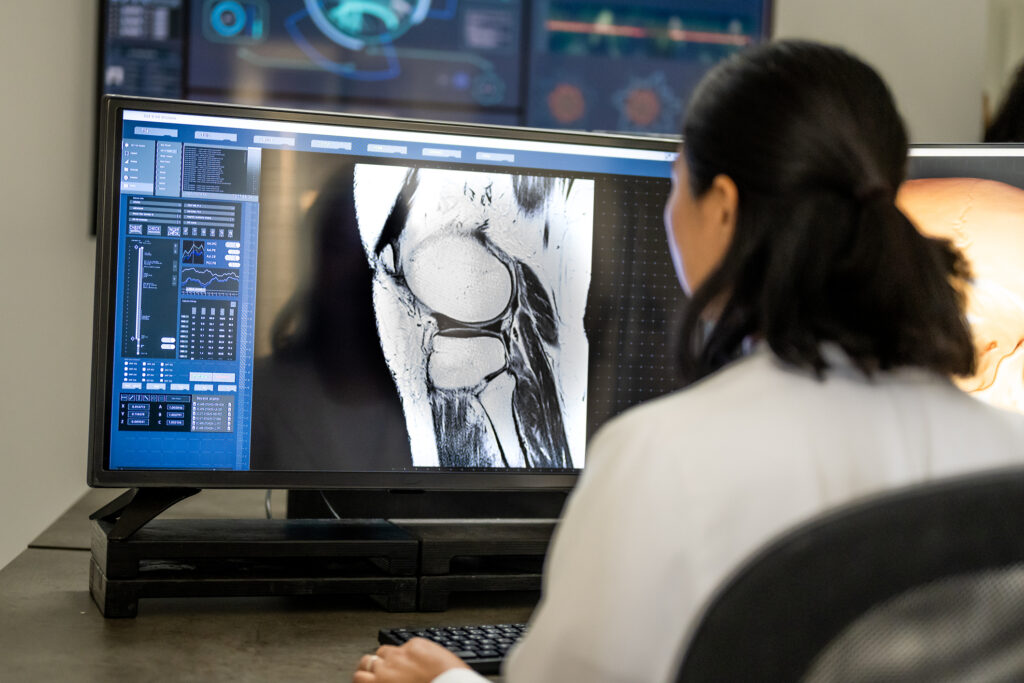
Rear view of female radiologist looking at the MRI image of the head and knee on her monitor and analysing it.
An inspection manager goes to the doctor… No, this is not a bad joke, but a really good story about what NDT can learn from medicine, and especially radiology, in terms of digital workflows. After all, the path to “diagnosing” a knee and a component is almost identical. This was also discovered by NDT inspection manager Holger W. – and today he is a convinced DIMATE PACS user.
Holger had what he calls his awakening experience after a skiing accident two years ago in which he injured his knee: “During the initial treatment in the hospital and also in the later course of treatment, I was fascinated by how seamlessly and smoothly the information and images flowed and how little paper was in use at all. In the end, the X-ray of my knee and the entire process around it is comparable to the inspection processes in our company – except that not everything here was as digital as it is in medicine. That made me wonder, and I talked to my radiologist about how my data and images were so effortlessly put together and always in the right place at the right time, without having to manually transfer anything.”
Digitizing Processes with a PACS
When it comes to digitizing workflows for evaluating and handling image data from X-rays, computer tomography, ultrasound or even endoscopy, radiology is an absolute pioneer. As recently as the last century, DICOM was developed as an IT standard that made it possible to unite image data from different sources and manufacturers in one software package – the Picture Archiving and Communication System, or PACS – for short. The PACS is the pivotal point of digital workflows. But what exactly can and does the PACS do in radiology?
The PACS is closely connected to the radiology and hospital information systems. From these information systems, it receives the patient data and also the order information, which examination is to be performed in which way. This information is automatically transferred to the PACS and from there, in a centralized manner, to the examination device as well.
In the case of Holger’s knee diagnosis, the radiologist therefore only had to enter the key data of the examination – which knee, which angle, etc. – into the information system once. From there, they were transmitted to the digital X-ray device via the PACS together with the patient demographic data. After the examination, the images of the knee inclusive the metadata with information on the examination details were automatically transferred to the radiologist’s PACS, where they could be evaluated in the patient context. In the context of the patient means that the radiologist was able to refer to previous diagnostic reports and images to make comparisons when evaluating the images. After the radiologist made the diagnosis of Holger’s knee, the images and report went into Holger’s medical record. If he returns to the hospital for treatment in the future, the doctor will have immediate access to this data.
“What fascinated me most was the fact that there is only one system for all examinations. And also only one central processing and storage location for the images and reports. The PACS is also the image archive, which can be accessed at any time at the click of a mouse. The images are then called up in the patient context and in connection with preliminary examinations. After the conversation with the radiologist, I asked myself why we were still handling Excel lists, entering the examination data by hand, and thus accepting transfer and assignment errors, which ultimately lead to a poorly managed archive and faulty processes,” remembers Holger, who immediately after his recovery started searching whether such a PACS was not also available for NDT.
At DIMATE he found the industrial PACS
That’s how Holger ended up at DIMATE, whose technological roots lie in the medical PACS world and who have transferred the entire workflow in all its digital sophistication to the NDT world. “The basis for this is the DICONDE IT standard, which has been specially adapted to the needs of materials testing. The DIMATE PACS supports this globally recognized IT standard throughout and thus creates the simple transfer of order data, test images and measurement results between the information systems and the test equipment or the test service providers. And of course, the PACS also takes over the secure archiving of the images and test reports and creates entire lifespan files of components or plant parts, comparable to patient files in medicine,” explains Peter Rosiepen, Managing Director at DIMATE.
Integration of artificial intelligence
“By the way, the possibilities for inspection data analysis offered by the PACS should not be underestimated. In the DIMATE PACS, I have a whole toolbox at my disposal that supports me in the evaluation of the inspection images,” explains Holger. Soon even with the support of AI applications – also an adaptation of experiences from radiology. Artificial intelligence has been used here for some time to support radiologists in their work, for example, by automating measurements or by suggesting measurement points from the AI. Peter Rosiepen explains, “In medicine, AI is used for dull routine tasks, for example, to detect and measure tumor foci in certain regions of the body. In addition, AI can now make suggestions as to which pathology a finding exhibits and develop diagnostic suggestions from this, which help the radiologist reach a good result more quickly and in a more standardized manner. And that’s exactly what we can implement for NDT.”
For example, the DIMATE PACS will automatically overlay the correct inspection instruction on the test image and preset the correct measurement points, ensuring that images are always created in the same way and always evaluated at the same points. In addition, the AI can detect whether, for example, a pipe wall thickness is within the standard range or not and draw the inspector’s attention to this. “The fact that my job will be eliminated by such developments is not something I’m afraid of. On the contrary, at a time when there is a shortage of skilled workers, digitalization is the only way to inspect components with the same quality and in the same time. In retrospect, I’m quite happy about my skiing accident, because it opened my eyes to the many advantages of digital workflows,” Holger concludes happily.
Would you like to learn more about the potential of our software? Contact us at buddy@dimate.de
Share This:




